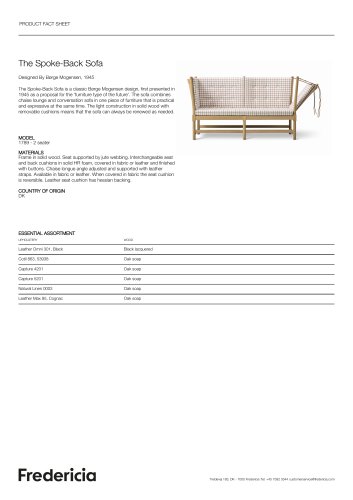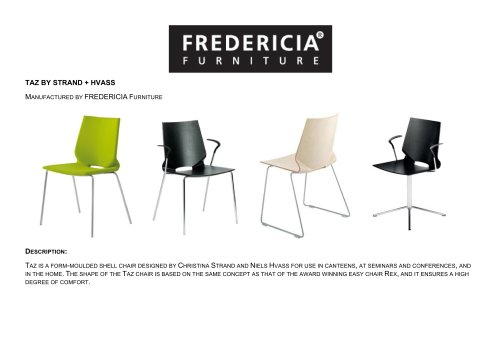
Catalog excerpts

Børge Mogensen was born in Aalborg, Denmark in 1914 and embarked upon his career in the world of design as a cabinetmaker in 1934, before entering the Copenhagen School of Arts and Crafts in 1936. It was there that he studied under his mentor, Kaare Klint, who he would work extensively with in his early years, before progressing to the Royal Academy of Fine Arts, from which he graduated in 1942. It was evident from early on that Mogensen was an extremely productive and ambitious person, as he became head of design at FDB soon after graduation, as well as simultaneously spending several...
Open the catalog to page 3
Børge Mogensen was often criticised for stubbornly insisting on tradition instead of exploring new materials, methods and trends
Open the catalog to page 4
Thankfully Børge never gave a damn The Spanish Chair
Open the catalog to page 5
Børge Mogensen’s home
Open the catalog to page 6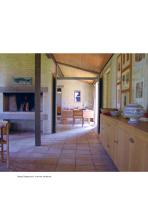
Børge Mogensen’s summer residence
Open the catalog to page 8
It’s interesting that a designer of Børge Mogensen’s talent should be such a well kept secret. As a design student I knew about Jacobsen, Wegner, Kjærholm, Panton and some others, but not Mogensen. It was not until relatively recently that I found out that he designed so many of the classic Danish furniture pieces that I admired. Many of his designs had infiltrated my reservoir of references without my being aware of their author. If I ask myself how this could have happened the only answer I can find is that Mogensen designs are intentionally discrete, he didn’t set out to design anything...
Open the catalog to page 9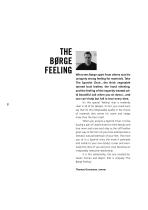
What sets Børge apart from others was his uniquely strong feeling for materials. Take The Spanish Chair…the thick vegetable tanned butt leather, the hand stitching, and the feeling of the expertly treated solid beautiful oak when you sit down…and one can’t help but fall in love every time. It’s this special ‘feeling’ that is evidently clear in all of his designs. In fact, you could even say that it’s this indisputable quality in the choice of materials that carries his name and image more than the form itself. When you acquire a Spanish Chair, it is like buying a pair of Lloyd’s shoes for...
Open the catalog to page 12
type of chair and is very common in areas influenced by ancient Islamic culture – from Spain to northern India. Børge Mogensen modernised the design by removing the elaborate carvings, and thus he created his own version with his customary geometrical precision. Yet he retained the most important feature: the broad armrests that give the chair its distinctive character. The broad armrests also serve as a practical place to place a cup or a glass. By designing The Spanish Chair Mogensen proved that he did not need to use steel or plastic to be innovative. Like The Hunting Chair, it is made...
Open the catalog to page 15
The people’s chair It is believed that it was a surplus of wooden pins and dowels in the factory stores that led Børge Mogensen to design J39 in 1947. Perhaps that was a fortunate coincidence, as today it is one of Denmark’s most sold wooden chairs, and has been in uninterrupted production ever since it was launched. J39 is the obvious choice for everything from canteens to conference halls, churches to private homes, and is popularly known as the People’s Chair. This simple, yet unique chair was inspired by Mogensen’s mentor, Kaare Klint, as well as American Shaker furniture. The curved...
Open the catalog to page 16
15 ‘The People’s Chair’ is truly deserving of its name – it is one of the most sold wooden chairs in Denmark.
Open the catalog to page 17
To this day, the J39 seat is corded by hand. One chair requires 144 metres of paper cord.
Open the catalog to page 18
17 Since the J39 was introduced, the seat height has been raised 2 centimetres, as people today are taller on average than they were in 1947.
Open the catalog to page 19
Christian Holmsted Olsen, head of collections and exhibtions at Design Museum Denmark speaks of Børge Mogensen as a ‘bone dry’ designer, a stubborn disciple of Kaare Klint’s design ideals, especially in the treatment of wood so that the owner of the furniture could appreciate not just the design, but also the tree from which it came from. “In keeping with this tradition, FREDERICIA has become one of the crown jewels of Danish design”, says Olesen. “From the 1950s, when FREDERICIA started working with Børge Mogensen, Danish furniture design has become what us Danes are best known for...
Open the catalog to page 20
says that a designer ‘stands on the shoulders of others’ in creating new designs, which is evident in Børge’s J39 chair in which he found inspiration in Klint’s own church chairs. Klint himself was influenced by the old church chairs from the Middle Ages. So when Jasper Morrison modeled the Trattoria chair after the J39, with a plastic seat and back that could be removed for shipping ease, he was also standing on the shoulders of his predecessors, both as an attempt at improvement and a tribute to Mogensen at the same time, as well as proving a love for a chair that is actually already more...
Open the catalog to page 21
Danish secretaries of state have furnished their offices with 2200s since the sixties, so today they have an image of power
Open the catalog to page 22
The politicians that is The 2200 series
Open the catalog to page 23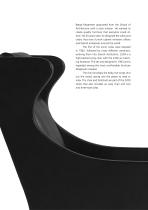
Børge Mogensen graduated from the School of Architecture with a clear mission. He wanted to create quality furniture that everyone could afford. Yet 20 years later, he designed the sofas and chairs that now furnish cabinet ministers offices and Danish embassies around the world. The first of the iconic sofas were released in 1962, followed by many different variations, evolving them into Danish institutions. 2204 is a high-backed wing chair with the 2202 as matching footstool. The set was designed in 1963 and is regarded among the most comfortable furniture Mogensen created. The chair...
Open the catalog to page 24
23 Quality takes time – a 2204 chair takes 4 hours to upholster.
Open the catalog to page 25
“A little herring, a little warm and cold smørrebrød, a little schnapps, a little beer, a little coffee, and a good nap on the Mogensen sofa”. 2213 became an institution in Danish homes in the sixties, and was immortalised in the above quote by Leif Panduro, describing a typical Danish New Year’s celebration. .
Open the catalog to page 26All Fredericia Furniture catalogs and technical brochures
-
Collection Book 2023
418 Pages
-
THE SPOKE-BACK
3 Pages
-
Søborg
3 Pages
-
BM61
3 Pages
-
J39
3 Pages
-
Collection 2021
215 Pages
-
FF Colour World 2021
56 Pages
-
FF Sustainability 2021
48 Pages
-
colour worlds
77 Pages
-
News 2018
36 Pages
-
The modern original
124 Pages
-
collection overview 2018
23 Pages
-
News 2017
32 Pages
-
Lookbook 2015
51 Pages
-
SERACS
2 Pages
-
C18
2 Pages
-
6286 | 6289
2 Pages
-
MICADO
2 Pages
-
J63 STOOL
2 Pages
-
J64 CHAIR
2 Pages
-
J16
2 Pages
-
GALLERY
2 Pages
-
TRINIDAD
4 Pages
-
NANNA LOUNGE CHAIR, X-FRAME
2 Pages
-
HAUGESEN TABLE
2 Pages
-
SLIM JIM
2 Pages
-
MUNDO CHAIR
4 Pages
-
MUNDO LOUNGE
2 Pages
-
EASY TABLES
4 Pages
-
STINGRAY
4 Pages
-
FUNK CHAIRS
4 Pages
-
PATO Sledge base
8 Pages
-
SOLA table
2 Pages
-
MESA table
2 Pages
-
BM BOOK
60 Pages
-
LOOKBOOK
79 Pages
-
THE COUPÉ SOFA
2 Pages
-
ICICLE
2 Pages
-
FUNK
4 Pages
-
NANNA BENCH
2 Pages
-
Nara
4 Pages
-
Haiku
2 Pages
-
J146
4 Pages
-
Pato
8 Pages
-
Astral
2 Pages
-
Spine
2 Pages
Archived catalogs
-
collection 2009/2010
152 Pages
-
huns J wagner
6 Pages
-
STINGRAY by Thomas Pedersen
3 Pages
-
MUNDO by Susanne Grønlund
3 Pages
-
Børge Mogensen Collection
64 Pages



